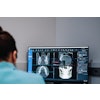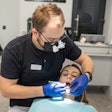
A team of physicists at the University of Liverpool in the U.K. have been awarded 534,000 pounds ($642,000) from the National Institute for Health and Care Research (NIHR) to develop a new oral cancer diagnostic tool.
A team from the university's department of physics in collaboration with the Liverpool Head and Neck Center has received the award under an NIHR Invention for Innovation grant program. The group will develop what it calls the Liverpool Diagnostic Infrared Wand (LDIR), a handheld device that identifies mouth lesions that may develop into cancer, the university said in a statement.
More than 12,000 oral cancer cases are diagnosed in the U.K. each year, and early diagnosis is key to better patient outcomes, according to a news release issued by the university. Determining which mouth lesions (dysplasia) will become malignant can be tricky, and the effort to do so may result in unnecessary treatments or tissue sampling. The current protocol for predicting malignancy of mouth lesions is microscopic assessment of the tissue.
A team led by Peter Weightman, PhD, is developing the wand for use in histopathologic laboratories. It uses infrared lasers and a machine-learning algorithm to predict future malignancy of current mouth lesions in patients. The project is the culmination of a decade of research that has been supported by the Engineering and Physical Sciences Research Council (EPSRC), Cancer Research U.K., and the U.K. Innovation and Research's EPSRC Impact Acceleration Award.
"This award from NIHR provides us with the opportunity to develop a prototype of the LDIR Wand that has the potential to transform oral cancer diagnosis," Weightman said. "While this application is focused on oral cancer, our approach should be applicable to any cancer where the diagnosis is based on the analysis of biopsies."



















